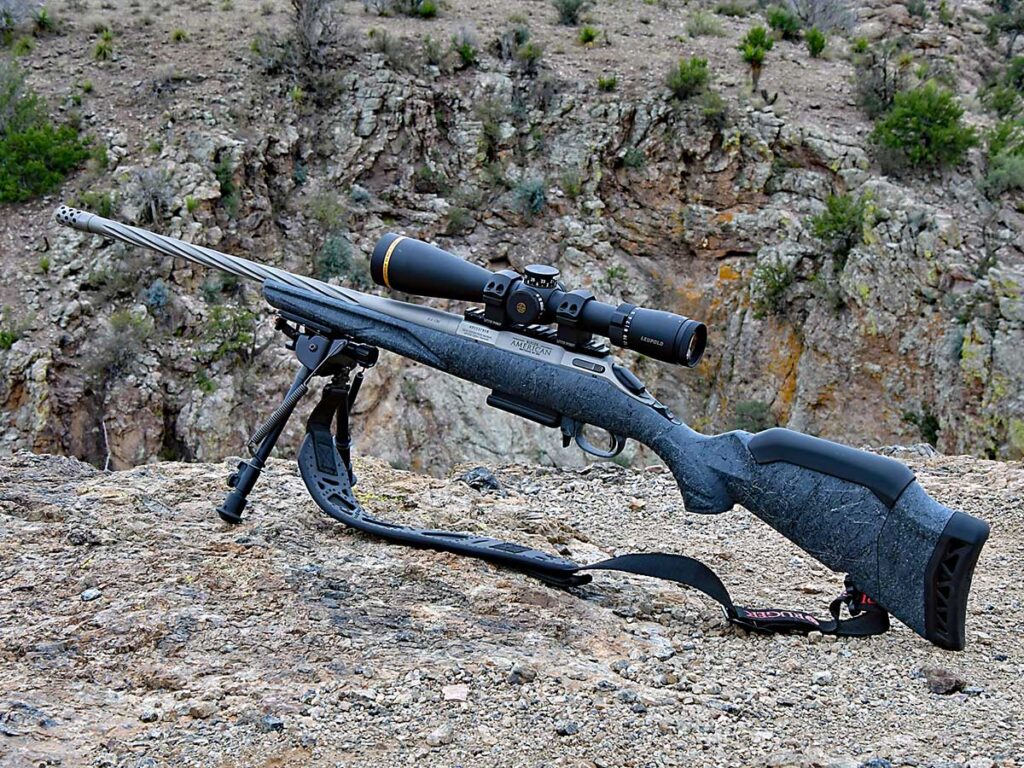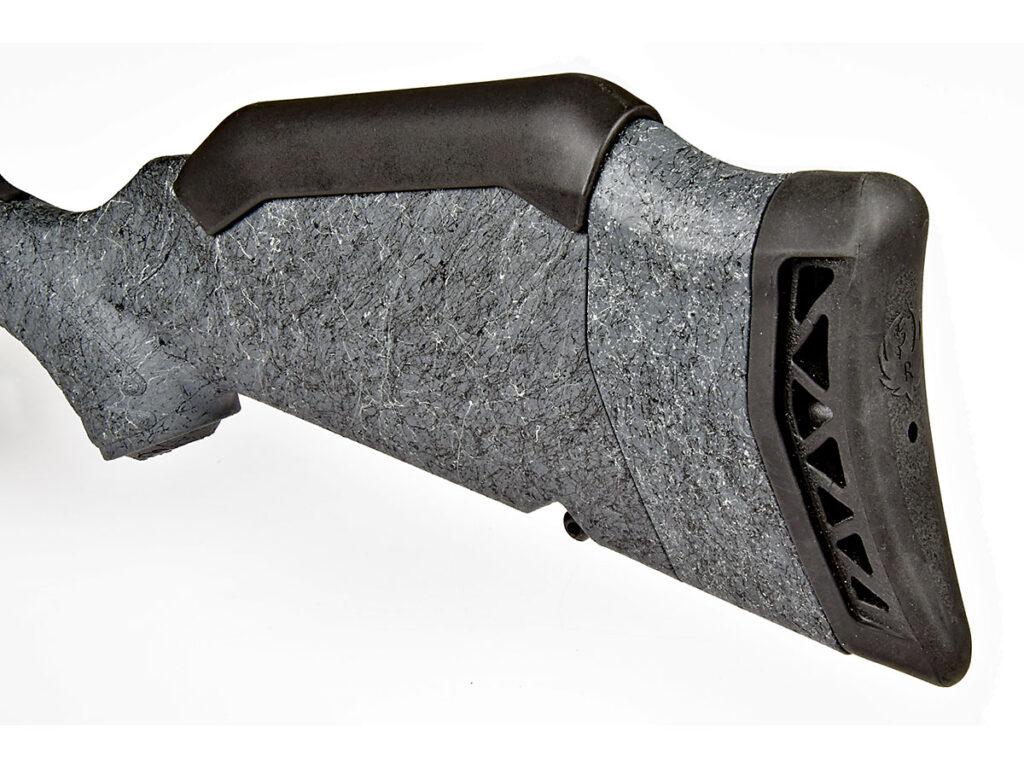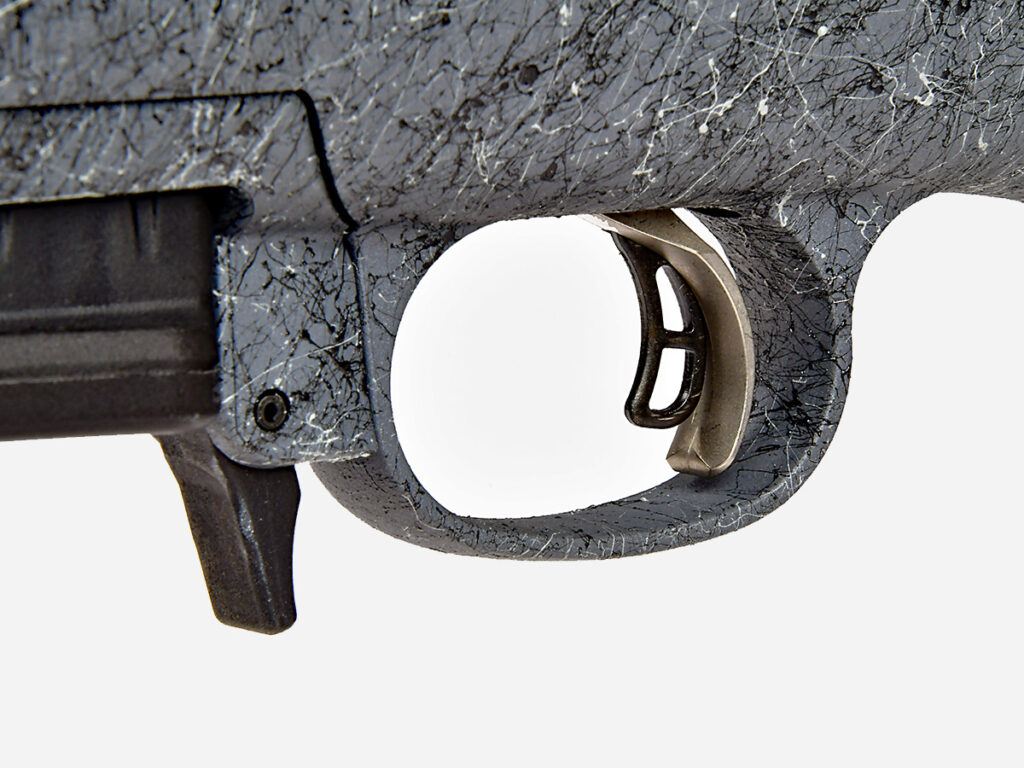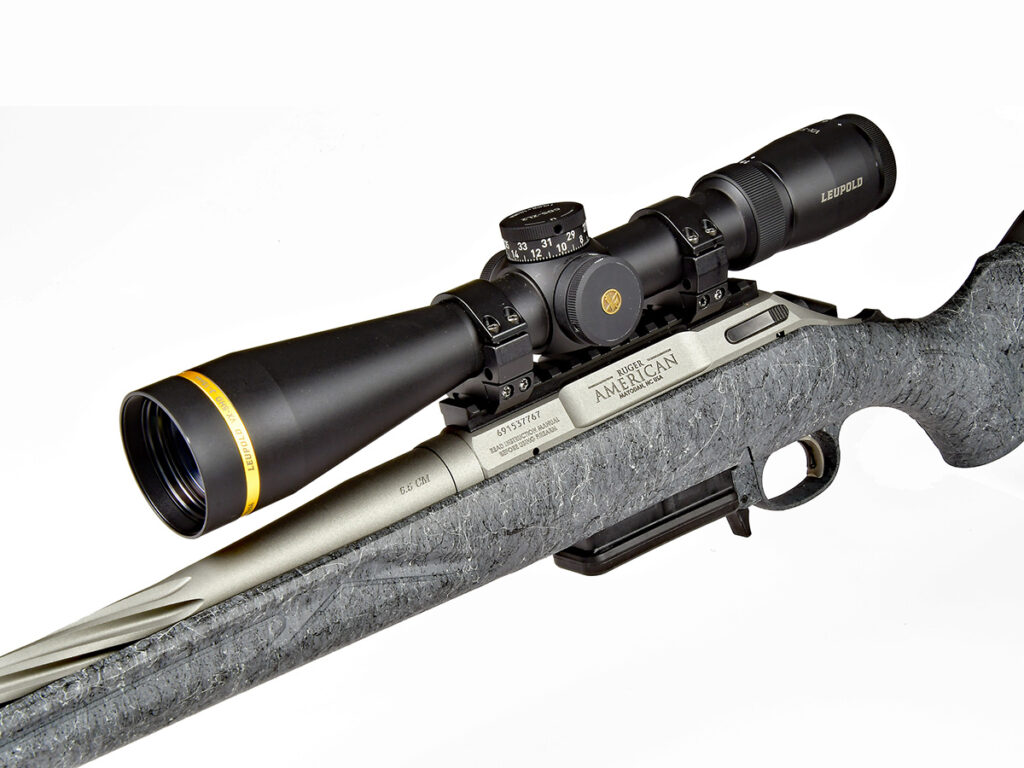Ruger’s American rifle is more than just another affordable bolt-action. It’s an American success story.
Every so often a rifle comes along that is so utilitarian—and affordable—that it becomes nearly ubiquitous. Everyone, it seems, either has one or wants one. The Ruger American is one such rifle. Following its introduction in 2011, it rapidly became one of America’s most popular affordable bolt-actions, and sales quickly exceeded Ruger’s expectations. To date, Ruger has delivered well over a million of them in 28 different chamberings and more than 250 distinct models.

What most people don’t know is that the American was intended to be something entirely different. Ruger engineers initially tried to create a more affordable version of the company’s venerable M77 Hawkeye flagship bolt-action rifle, but they could only go so far working with the legacy design.
A Clean-Sheet Design
That prompted a decision to go with a clean-sheet design, and three experienced Ruger engineers were assigned to the project. Step one was gathering input from a “Voice of the Customer” campaign to find out what customers really wanted. Ruger’s polling produced some interesting results.
“With enough folks polled, many features or choices canceled out,” says Mark Gurney, Ruger’s innovation director. For example, about one-third wanted push feed, one-third wanted controlled-round feed, and one-third didn’t care. Much the same applied to decisions over whether the safety should be a tang or wing design, and whether the ejector should be a plunger or fixed type.
In the end, several factors emerged as constants. The rifle needed to be accurate and have a good trigger. It needed to be rugged. And reliable. In other words, it needed to be a Ruger.
From the time Ruger committed to the American, it took a little over a year to bring the design to life. A team of manufacturing engineers were added to the effort during the development cycle and Ruger stood up the first dedicated American rifle production line in Newport, New Hampshire. In 2016, in response to demand, Ruger added additional production capacity in its Mayodan, North Carolina, facility.
The Original American
When first introduced, the American was a no-frills rifle designed to hit a certain price point. It did that handily. Original MSRP was just $449 (it retailed for less), but from the beginning, the rifle delivered performance on par with guns costing far more.
The rifle was, unsurprisingly, originally chambered for some of America’s favorite cartridges, including .243 Win. and .308 Win. in short actions, and .270 Win. and .30-06 in long actions. It was equipped with a 22-inch free-floated hammer-forged barrel (with a recessed crown) attached to the action with a barrel nut for precise headspacing and enhanced accuracy.
The bedded action was mated to the stock using Ruger’s innovative Power Bedding System, which also contributed to the gun’s accuracy. That system used two aluminum V-blocks embedded into the synthetic stock that mate up with a pair of cuts in the action. It was a simple but clever design that worked quite well.
Use of a full-diameter bolt with three locking lugs and dual-cocking cams allowed for a short, 70-degree bolt throw and ample scope clearance. Smoothness of cycling varied a bit on these early guns. I handled some that were quite smooth and one or two others that felt a little stiff, but loosened up with lubrication and use.
The rifle employed the Savage-like bladed-style Ruger Marksman Trigger, but it differed from similar designs in one important respect. The blade locked the trigger, versus the sear, so the sear couldn’t trip no matter how low the pull weight was set. The pull weight was user-adjustable within a range of 3 to 5 pounds. The action used a two-position, tang-mounted safety that did not lock the bolt down.
In a departure for Ruger, the top of the action did not have the milled slots used on Hawkeye rifles for directly attaching Ruger scope rings. Instead, each rifle shipped with two single-slot Weaver-style bases to attach to the receiver.
The rifle had a matte black, glass-filled polypropylene stock. It wasn’t the stiffest stock in the world, but that shortcoming was negated by the stiffness of the action and the free-floated barrel. Stocks were equipped with a recoil pad that did a decent job of mitigating recoil. Stippled panels were impressed into the forend and grip to improve purchase in inclement weather. The rifle fed from a well-designed detachable, four-round rotary magazine that slid rounds smoothly into the chamber.
Visually, the original rifle didn’t look like anything special. At the time, it didn’t exactly stand out on rifle racks overflowing with other guns with black polymer stocks, but once people found out how well it shot, sales took off. In buyers’ eyes, beauty was in the rifle’s performance.
Unfailing Accuracy
I’ve had a fair amount of experience with Ruger American rifles, both in the field and on the range, starting with an American Predator model chambered in 6mm PRC. That rifle had a green synthetic stock and a fairly stiff-cycling bolt that made a bit of a zip-zip sound, which was somewhat common on early models and has since been corrected.
That rifle, which weighed just 6.6 pounds, had a 22-inch medium-contour barrel. Like all American rifles of that time, it had Ruger’s Power Bedding System, a tang-mounted safety, the Marksman adjustable trigger and a four-round flush-fitting rotary magazine. The push-feed action’s bolt had three large lugs, a generously sized extractor, a plunger ejector and a short, 70-degree throw. I wasn’t overly impressed with the rifle’s appearance, but my attitude toward the gun quickly changed when I put rounds downrange. On a day with the wind blowing full value at 12 mph, a Hornady load produced five-shot groups averaging 0.78 inch and a best group of just over half an inch.
I was even more impressed when I discussed the rifle with my friend and fellow outdoor scribe John Barsness. He shared a photo of a group he shot with the Predator in 6.5 Creedmoor with his handloaded ammo. All five shots went into a single ragged hole. That’s impressive performance for any rifle, let alone an inexpensive one. At the time, that American had an MSRP of $529, and you could find it at a real-world price a bit south of $400.
Every Ruger American rifle I’ve tested since then, regardless of chambering, has proven to be unfailingly accurate. Each has turned in sub-MOA groups with ammo it liked, which is more than I can say for some rifles costing far more. That inherent accuracy, combined with its affordable price tag, accounts for much of the Ruger American’s continued popularity in the years since its introduction.
Versatility in Spades
With that sort of performance and price, it’s no surprise that the rifle quickly gained a following and found itself at home in deer blinds and pickup trucks across America.
When first introduced, the American was offered with only a black synthetic stock. Initial chamberings were limited to a handful of popular cartridges. The lineup would quickly expand. In the rifle’s second year, Ruger added .22-250 Rem and 7mm-08 Rem. Ruger American Rimfire models appeared by 2015. Magnum chamberings, including 7mm Rem Mag and .300 Win. Mag., arrived in 2016.
Magnum calibers were prototyped very early in the American rifle’s life, but it wasn’t until 2016 that Ruger built them in any quantity. Today, only .300 Win. Mag. stands as the legacy magnum cartridge in the lineup, though some models have been chambered in 7mm Rem. Mag. and .338 Win. Mag. in the past. Such rounds have been mostly replaced by 6.5 PRC and 7mm PRC, which work with the magnum-sized American receiver and bolt, and feed well from Ruger’s three-round magnum box magazine. These magnums have quickly grown in popularity, especially with long-range shooters and Western hunters.
In 2016, the .450 Bushmaster made it into the lineup without a great deal of notice or fanfare, but it climbed into the number-three spot about a year later. It remains a staple of the line, and is a good choice for black bears, whitetails or hogs.
Over time, a few chamberings have been subtracted from the American lineup, but overall, the list has grown. As of this writing, some models are chambered for an astonishing 18 different cartridges, and I wouldn’t be surprised to see others added. Ruger has never been shy about embracing innovative cartridges—or partnering at times with ammo manufacturers to make them—so you can expect continued flexibility in its choice of chamberings for the American.
Notable Early Models
2014 was a banner year for the Ruger American. That’s when a slew of new models were added to the lineup. They included the All Weather and All Weather Compact models (Ruger introduced the Compact the year before). The All Weathers had 22-inch matte-stainless barrels, while the Compact variants had shorter lengths of pull and shorter barrels, and were designed for shooters of smaller stature.
One of the most important introductions that year was the Ruger American Ranch, which was, as its name suggests, designed to be a handy companion for dealing with situations that call for a quick-handling, maneuverable rifle. The Ranch differed from the standard American in several important ways.
First, it was chambered in 5.56 NATO, which is useful for dealing with predators, and in .300 Blackout, which is potent medicine for feral hogs. Barrels measured 16 inches, which was even shorter than the 18-inch barrels on Compact models, making the rifle easier to whip out the window of a pickup truck when needed. Notably, the barrels were threaded for use with suppressors. The American Ranch also came with a Picatinny rail in place of the more traditional optics mounting system, making it easier to change optics. The gun even looked like a ranch rifle with a flat dark earth finish on the stock. It weighed only about 6 pounds. MSRP at the time was $489.
Another important addition to the line that year was the Ruger American Predator, which sported a moss green composite stock. It featured a heavier-tapered, threaded 22-inch barrel, and came with a one-piece rail for mounting optics. As its name implies, the Predator was quite useful in the hands of predator hunters thanks to the fact that it was chambered for such varmint-dispatching rounds as the .204 Ruger, .22-250 Rem and .223 Rem. Despite its name, the Predator was capable of much more because it was also chambered for .243 Win, 6.5 Creedmoor and .308 Win. Rifle weight in most chamberings was 6.62 pounds. Its MSRP was also $489.
The year 2014 was also when Ruger made southpaws happy with the introduction of a Ruger American Left-Handed variant. When first introduced, the lefty model was a standard American model. Initial chamberings included .22-250 Rem, .223 Rem, .243 Win, .270 Win., 7mm-08 Rem, .30-06, and .308 Win. The MSRP was just $449. The Left-Handed rifle is still available in several chamberings in the American Predator rifle.
If you were willing to spend a couple of hundred dollars more that year, you could get an American packaged with a Redfield Revolution 3-9×40 scope. Later, packages were added with different scopes.
Over time, Ruger introduced new magazine styles to the American lineup, including AI-, AR- and Mini-Thirty-style magazines in addition to the existing flush-fitting rotary mag. 7.62×39 was the first new chambering added to the line with this capability, but AR-sized cartridges have benefitted the most from the addition of new types of magazines. Today, Ruger supports .350 Legend, .400 Legend, 6mm ARC, .22 ARC and 6.5 Grendel with AR mags from the factory in select rifle versions.
Going Wild
One of my favorite additions to the American line came in 2018 with the Go Wild. It featured an upgraded Go Wild camo synthetic stock, Cerakote finish, AI-type magazine, muzzle brake, and a Picatinny rail for optics. The Go Wild had an MSRP of just $629. I initially tested the model in 6.5 Creedmoor chambering, and was more than a little pleased with the results. The action cycled more smoothly than earlier models I had tried. Four of five tested factory loads turned in sub-MOA groups (the fifth load held 1-inch average groups). I used that rifle on a challenging West Texas desert mule deer hunt to cleanly drop a 3X3 management buck.
That rifle stood up to harsh conditions, including a terrific dust storm, and performed like a champ. I was so enamored with the rifle that I bought it, and it would still be in my inventory save for the fact that my son kept hinting that he thought it would make a fine birthday present. I later used another American Go Wild rifle chambered in 7mm PRC to swat a management Axis buck into the freezer. I only had one load to test in that rifle, but it also proved to be quite accurate, with average groups measuring 0.67 inch and a half-inch best group.
Current first-generation American rifle versions include the Standard, Predator, Ranch, Go Wild, Hunter, Compact, and a package option equipped with a Vortex Crossfire II riflescope. The Standard model, with a 22-inch barrel, is offered in seven popular chamberings. MSRP is $599.
The original Predator rifle has options that include 10 different chamberings, black or moss-green stocks, and varying barrel lengths. Depending on the model, magazines included flush-fit, AR-, or AI-style. MSRPs range from $610 to $699. Real-world prices are considerably less.
The Hunter model is notably equipped with a specialized Magpul Hunter American stock, featuring fully adjustable length of pull and comb height, and enhanced ergonomics. Hunter rifles are chambered in 6.5 Creedmoor or .308 Win. Some versions have shorter, heavy contour barrels. MSRP is $1,019, making this the most expensive rifle in the American lineup.
The Best Ruger American Yet
Fans of the Ruger American got a present with the Christmas Eve 2023 introduction of the Ruger American Gen II rifle, which improves considerably upon the original. The Gen II looks quite different than first-generation Americans, but improvements are more than skin-deep. The action still employs a one-piece, CNC-machined stainless bolt, but it cycles more smoothly and no longer has the characteristic “zip-zip” cycling sound of the early bolts. The bolt still has a short 70-degree throw to provide ample clearance for scopes. An oversized bolt knob is a definite plus.


Ruger upgraded the Gen II’s safety from a two-position type that did not lock the bolt down to a three-position, tang-mounted design that allows you to cycle rounds through the action with the safety in the middle, engaged position. It also locks the bolt down in the rearmost position. These features mark a big improvement over the safety in first-generation rifles.


The Gen II still uses Ruger’s Power Bedding integral block system, but the free-floated barrel is now deeply fluted to shed weight. The rifle I tested, chambered in 6.5 Creedmoor with a 20-inch barrel, weighed just 6.5 pounds, making it light enough for backcountry hunts. The muzzle is threaded for adding a suppressor or different muzzle brake, and Cerakote protects all the metal.


I have always found Ruger American rifles to be well-balanced in the hands, and that holds true for the Gen II.
A New Modular Stock
Also new with the Gen II is a modular stock design with a removable black comb, an effective recoil pad, and a removable spacer to adjust the length of pull. The standard Gen II’s stock has a textured black-and-gray splatter finish that nicely complements the dark gray Cerakote on the barrel and action. The splatter finish improves grip on the rifle, and the Gen II stock is noticeably stiffer than first-gen stocks.


Happily, the Gen II addresses one design element that has always annoyed me. The trigger could always be adjusted, but it was a pain to do so because you had to remove a spring-loaded magazine release latch to access an action screw to remove the barreled action from the stock. I always found that lever to be difficult to get back into place. More often than not, I left trigger pull weights at their factory settings. The latest version of the magazine well has a notch that allows you to access the rear action screw with a 3/16-inch ball end hex wrench, greatly simplifying the trigger adjustment process.


I have always found Ruger American rifles to be consistently accurate, and the Gen II was no exception. In testing, a Gen II chambered in 6.5 Creedmoor produced sub-MOA groups with four of five tested factory loads. That accuracy came in handy at the conclusion of a mile-long stalk on an aoudad ram on a remote West Texas ranch. That’s rough country, where shots can be long, and aoudad can be tough to put down. The Gen II was up to the task.


The standard Gen II rifle is currently offered in 18 chamberings, ranging from common cartridges such as the .243 Win, 6.5 Creedmoor, .270 Win, 7mm-08 Rem, .30-06 and .300 Win. Mag., to straight-walled rounds (.350 Legend and .400 Legend) and newer options such as 6.5 PRC and 7mm PRC. Barrel lengths, magazine styles, and capacities for American Gen II rifles vary by chambering.
There’s also a quick-handling Gen II Ranch rifle, offered in nearly a dozen chamberings, with a flat dark earth/black splatter-finished stock and shorter barrels measuring a bit more than 16 inches.
Gen II Predator rifles, available in 18 chamberings, have a Burnt Bronze Cerakote finish and a green stock with black and bronze splatter texture. They feature 22-inch barrels to achieve greater velocities.
Continuous Improvement
As the Gen II rifles amply demonstrate, Ruger has continuously improved the American rifle over the years. In 2017, for example, Ruger changed American barrels from six-groove rifling to five-groove, claiming it reduces bullet deformation, makes barrels easier to clean and ultimately results in greater accuracy potential.
“It’s the hidden details that help us win with continuous improvement,” says Matthew Willson, Ruger product manager.
“Engineers spent a lot of time working to improve bolt feel and made improvements in the bolt, receiver, and bolt stop that all played a part in making Gen II feel better than American rifles had in the past.”
An important part of that process is what Ruger engineers call “tolerance stack-up” analysis. This involves, for example, looking at the magazine, magazine well, mag latch, stock, receiver and barrel to ensure all the components align to put the magazine at the correct height to feed a cartridge into the chamber smoothly.
Ruger’s Voice of the Customer Campaign was a key factor in designing the Gen II American. Ruger collected information from a broad group of customers, including consumers, industry insiders, buyers at independent and chain retailers, and wholesale and law enforcement distributors.
Information was gathered via mechanisms ranging from formal surveys, questionnaires and focus groups to informal feedback and even social media. Says Willson, “We had quite a list going into American Gen II development from years of feedback compiled at shows, shoots, retail events, customer service interactions, and even through the ‘Tell the CEO’ function of the Ruger website.” Ruger listened, and the results are reflected in Ruger’s best American rifle to date, the Gen II.


Looking Ahead
By the time you read this, Ruger will likely offer the Gen II American in additional versions and chamberings. As noted, Ruger currently offers seven traditional American rifle models and three American Gen II models, but that will change.
“The original adaptation of American Rifle will remain for now, but will see a reduction in models so we can focus production on the highest-demand models of Gen II. The American Gen II will continue to grow with new configurations and calibers,” says Willson.
The MSRP for all Gen II rifles is just $729, and you can often find them for a little more than $500. All indications point to the Gen II being on the same trajectory to success as the first-generation Americans. It’s a refined rifle, and has more of the features today’s shooters want, but it still reflects the core Ruger American attributes: accurate, reliable and affordable.
Ruger has a long and rich legacy of creating American-made firearms that deliver solid performance at an affordable price. The Ruger American does that in spades, and that will likely ensure its ongoing popularity into the foreseeable future.
The Ruger American is an aptly-named rifle. It’s a great success story, and few things are more American than that.
Editor’s Note: This article is an excerpt of Gun Digest 2026, 80th edition.
More On Hunting Rifles:


Next Step: Get your FREE Printable Target Pack
Enhance your shooting precision with our 62 MOA Targets, perfect for rifles and handguns. Crafted in collaboration with Storm Tactical for accuracy and versatility.
Subscribe to the Gun Digest email newsletter and get your downloadable target pack sent straight to your inbox. Stay updated with the latest firearms info in the industry.
Read the full article here







Leave a Reply